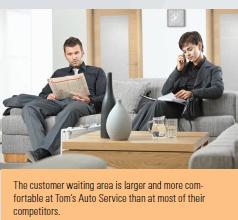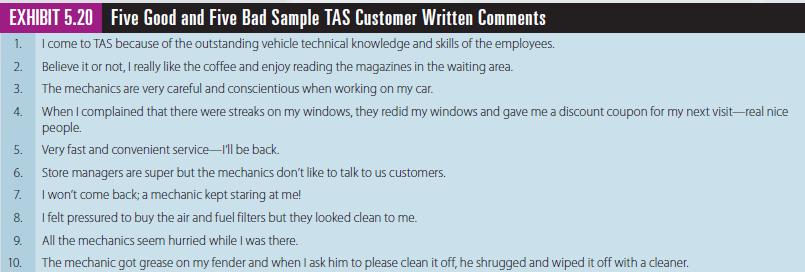Toms Auto Service (TAS) is a regional quick-service vehicle oil-change and lubricant-change service somewhat similar to Jiffy
Question:
Tom’s Auto Service (TAS) is a regional quick-service vehicle oil-change and lubricant-change service somewhat similar to Jiffy Lube and Tuffy Tire & Auto Service. TAS seeks to differentiate its 32 stores from competition by focusing on peripheral goods and services, the servicescape, and customerfriendly employees. The primary customer benefit package consists of friendly, professional employees who regularly interact with customers, providing oil, oil filters, air filters, tires, windshield wiper blades, and lubricants. Automotive associations also certify TAS mechanical and technical personnel, and their certificates are displayed in the customer waiting room. All technical work is guaranteed for 90 days.
Employees are carefully interviewed for employment, and background checks are done on technical skills and criminal history. Video on-the-job-training is required of all new hires.
All employees are trained to operate the store cash register and payment software. Store managers are responsible for the overall store operations and the customer waiting lounge.

Many other peripheral goods and services define TAS’s customer benefit package. For example, the customer waiting rooms include several blends of fresh coffee and tea, sodas, current magazines, Wi-Fi, and a high-definition television.
Customers receive vehicle maintenance brochures and discount coupons for their next visit. TAS also offers other services, such as cleaning the vehicle’s windows outside and inside, vacuuming carpets, reviewing service history with the customer, and explaining the technical aspects of vehicle service if the customer asks or if a potential safety or mechanical problem is discovered.
The facility layout consists of four service bays, with a pit below three of the bays for draining and changing oil and lubricants. All necessary tools and equipment are provided for each bay. The customer waiting area is carpeted and larger than those of competitors, with comfortable sofas and chairs. A large window in the waiting area allows customers to see their vehicles being serviced in any of the bays.
Employees are professionally dressed in clean blue uniforms, paid for by TAS, with their first names embroidered on them. To maintain a professional appearance, employees are required to wash their arms and hands after each service job.
A vehicle checklist is used to ensure completeness of the work and as a means of quality control. The standard time to complete a routine job is 18 minutes in the bay area, plus nine minutes for customer check-in and checkout. Other work, such as changing tires, takes longer. Store managers and assistant managers are trained and empowered to approve free service if the customer is dissatisfied for any reason.
TAS surveys customers regularly as a way of understanding customer satisfaction. Results from 206 customer surveys are summarized in Exhibit 5.19. Samples of good and bad written customer comments are shown in Exhibit 5.20. These results are over the past three months for nine randomly selected stores. Store managers never know when their store may be in the corporate survey results. The corporate vice presidents of marketing, human resource management, and operations were asked to analyze these data to determine what actions might be necessary to reward or improve performance.
 The VP of operations, David Margate, decided to analyze this information. A final report to the CEO was due in two weeks. To assist Mr. Margate, answer the following questions.
The VP of operations, David Margate, decided to analyze this information. A final report to the CEO was due in two weeks. To assist Mr. Margate, answer the following questions.
Case Questions for Discussion:
1. Define and draw the customer benefit package, and state TAS’s mission, strategy, and rank order of competitive priorities.
2. Identify and briefly describe the eight “design”
features, described in Sections 5.4 and 5.5, of the
(a) service-delivery system and
(b) service encounters.
3. Identify and briefly describe five processes TAS stores use and their relative importance.
4. Given your analysis of the survey data, what opportunities for improvement, if any, do you recommend?
5. Summarize your final recommendations to the CEO.


Step by Step Answer:






